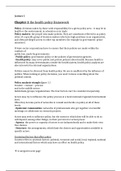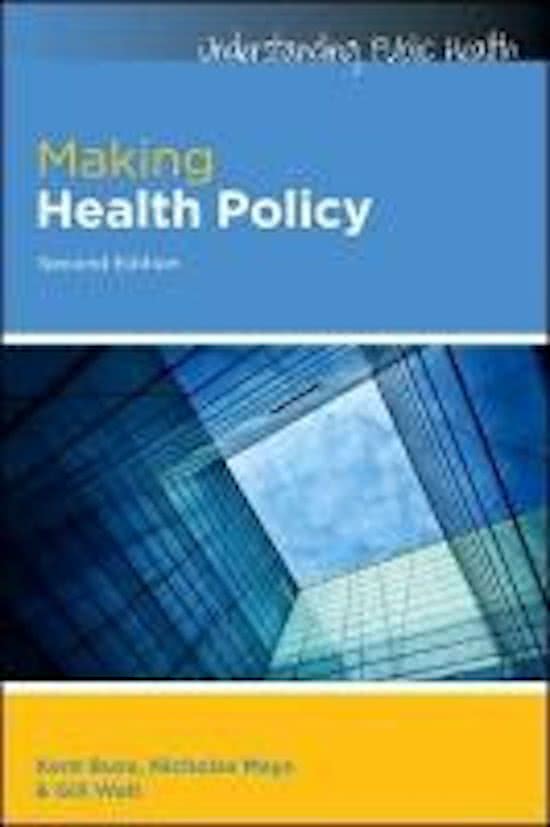Lecture 1
Chapter 1 the health policy framework
Policy: decisions taken by those with responsibility for a given policy area – it may be in
health or the environment, in education or in trade.
Policy makers: the people who make policies. They are sometimes referred to as policy
elites a specific group of decision makers who have high positions in an organization,
and often privileged access to other top members (for example in government: prime
ministers).
Private sector corporations have to ensure that their policies are made within the
confines of
public law, made by governments.
- Public policy: government policy or the policies of government agencies.
- Health policy: may cover public and private policies about health. Because health is
influenced by many determinants outside the health system, health policy analysts are
also interested in external organizations.
Politics cannot be divorced from health policy. No one is unaffected by the influence of
politics. When looking at policy decisions, you need to know something about the
political context.
Policy analysis triangle figure 1.1
Context – content – process
and in the middle actors:
Individuals/groups/organizations. The four factors can’t be considered separately.
Actors may try to influence the policy process at a local/national/regional/international
level.
Often they become parts of networks to consult and decide on policy at all of these
levels.
- Epistemic communities: networks of professionals who get together at scientific
meetings or collaborate on research projects.
Actors may seek to influence policy, but the extent to which they will be able to do so
will depend, among other things, on their perceived or actual power.
- Agency: the power or capacity of actors to act independently and to make their own
free choices.
- Structure: the arrangements, which limit the choices and opportunities available to
specific actors.
Contextual factors that affect policy
Context refers to systemic factors: political, economic and social, local, regional, national
and international factors which may have an effect on health policy.
4 categories next page
, 4 categories:
1. Situational factors: transient or idiosyncratic conditions which may influence policy
(for example: wars, earthquake).
2. Structural factors: the relatively unchanging elements of society (for example:
political system, type of economy, employment base).
3. Cultural factors: position of ethnic minorities or linguistic differences. Also gender
differences, religious factors.
4. International or exogenous factors: some health problems demand cooperation
between national, regional or multilateral organizations.
Process refers to the way, in which policies are initiated, developed or formulated,
negotiated, communicated, implemented and evaluated.
The most common approach to understanding policy processes is to use what is called
the ‘stages heuristic’: breaking down the policy process into a series of steps, but
acknowledging that this is a model, and does not necessarily represent exactly what
happens in the real world.
Think of policy making in these stages:
1. Problem identification and issue recognition: explores how some issues get on to the
policy agenda, while others do not even get discussed.
2. Policy formulation: explores who is involved in formulating policy, how policies are
arrived at, agreed upon and how they are communicated.
3. Policy implementation: most important.
4. Policy evaluation: identifies what happens once a policy is put into effect – how it is
monitored, whether it achieves its objectives and whether it has unintended
consequences.
When using this, be aware of the fact that the policy process is not linear rational
process iterative.
Institutions can mean two things:
1. An organization (for example WHO)
2. The rules, authority and values of an organization and the ways in which it makes
decisions or acts.
Nr 2 is most important when looking at policy processes.
Interests refer to actors who may be individuals or groups, organized or informal and
who want to see policy that furthers their goals or at least does not threaten their
attainment.
It is also possible to use ‘issue characteristics’ which may affect policy: specific features
of a particular issue (which could be a problem or a solution).
The policy triangle can help to analyze or understand a particular policy (analysis of
policy) or you can apply it to plan a particular policy (analysis for policy).
1. Analysis of policy is generally retrospective and explanatory.
2. Analysis for policy is prospective






